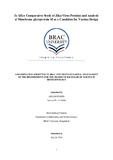| dc.contributor.advisor | Hossain, Dr. M. Mahboob | |
| dc.contributor.author | Nowshen, Afia | |
| dc.date.accessioned | 2018-09-16T07:35:40Z | |
| dc.date.available | 2018-09-16T07:35:40Z | |
| dc.date.copyright | 2018 | |
| dc.date.issued | 2018-07-26 | |
| dc.identifier.other | ID 13136006 | |
| dc.identifier.uri | http://hdl.handle.net/10361/10548 | |
| dc.description | This thesis is submitted in partial fulfilment of the requirements for the degree of Bachelor of Science in Biotechnology, 2018. | en_US |
| dc.description | Cataloged from PDF version of thesis. | |
| dc.description | Includes bibliographical references (page 72-75). | |
| dc.description.abstract | Zika virus is a (+) RNA virus that has become a major concern of public health in the last few years. It is known to cause microcephaly, reduction of brain circumference along with many type of brain injury in new-borns at a high rate. An effective vaccine against Zika virus is not yet discovered. In this investigation, a comparative study of Zika virus with its other relative species was performed. In order to do so, polyprotein sequences of 10 viruses (West Nile Virus, Rubella Virus, Dengue Virus 2, Human Immunodeficiency Virus 1 (Partial Polyprotein), Human Immunodeficiency Virus 1 (Partial Polyprotein), Ebola Virus (Structural Polyprotein), Chikungunya Virus (Non-Structural Polyprotein), Hepatitis C virus polyprotein, Cytomegalovirus Polyprotein) were analysed by Multiple Sequence Alignment using T Coffee (EMBL) and COBALT (NCBI) respectively. From the analysis, the most conserved regions among species were further analysed using InterProScan and ScanProSite for finding out their precise function and involvement. The overall biological processes, molecular function, and cell component characteristics were also identified. A phylogenetic tree considering 100% data coverage was also constructed. As an effort to find out an epitope for a probable peptide vaccine design, ZIKA virus Membrane Glycoprotein (M) was analysed because this was the only complete protein sequence submitted to NCBI so far. Using three distinct antigenicity and epitope prediction software, Vaxijen, BepiPred and BCPREDS five sequences were found to be antigenic. Among the five sequences, a seven amino acid long sequence ‘GSSTSQK’ and 12 amino acid long ENWIFRNPGFAL were determined to be most antigenic by Vaxijen (Antigenicity of GSSTSQK- 1.1341 and ENWIFRNPGFAL- 0.8161 where threshold value of antigenicity ≥ 0.4). These sequences have a high antigenicity, conservancy and surface accessibility suggesting that, these might be epitopes that are most compatible for designing a peptide vaccine.
Here a complete comparative study of Zika virus with its relatives were conducted to get insights about how Zika virus works. Alongside, identification of peptide vaccine candidate epitopes was done using bioinformatic tools. | en_US |
| dc.description.statementofresponsibility | Afia Nowshen | |
| dc.format.extent | 75 pages | |
| dc.publisher | BRAC Univeristy | en_US |
| dc.rights | BRAC University theses are protected by copyright. They may be viewed from this source for any purpose, but reproduction or distribution in any format is prohibited without written permission. | |
| dc.subject | Zika virus | en_US |
| dc.subject | Vaccine | en_US |
| dc.title | In silico comparative study of Zika Virus Proteins and analysis of Membrane glycoprotein M as a candidate for vaccine design | en_US |
| dc.type | Thesis | en_US |
| dc.contributor.department | Department of Mathematics and Natural Sciences, BRAC University | |
| dc.description.degree | B. Biotechnology | |

